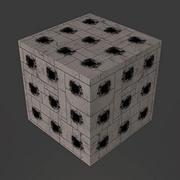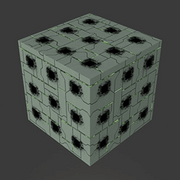Description[ | ]
Thrusters are secondary engines, that add both maneuverability and turning capability to a Ship. They do not participate in forward acceleration, which is handled by Engines.
Thrusters will react automatically to player input and change a ship's attitude along any of the three axes allowing the ship to strafe, roll, brake and reverse. Similar to Engines, Thrusters operate against the ship's total mass, therefore heavier ships will benefit less from the same volume of Thrusters. Black spots on the active surfaces of Thruster blocks represent the nozzles, which produce force in the opposite direction of the given face, i.e. nozzles pointing forward will always activate to help braking when a ship is drifting forward and to accelerate it backwards. While volume of each particular Thruster block directly affects the relevant output, it's position and facing on the ship is equally important, as it will directly determine the behavior of the given Thruster in response to different players actions. Material of the Thruster block only affects its durability and has no effect on the thrust output.
There are two types of Thruster blocks available - Thruster and Directional Thruster. Regular Thrusters have nozzles on every of the six sides of a block, and in that way are a more universal and simple solution for providing maneuverability.
A Directional Thruster only has nozzles at two opposing sides, which are pointed along a desired axis by rotating the block, and will affect only that axis for turning, strafing and braking. However, it has 2.5 times greater thrust along that axis.
- Turning thrust along a certain axis is provided by placing Thrusters away from the center of mass of the ship - the further, the better. Placing them away by one axis provide more powerful output, while doing so from two or three axis lines will provide more universal total output, but a lesser output along each individual one. Thrusters placed directly into the center of mass will only improve braking and strafing.
- Strafing thrust is provided by any Thruster facing in the corresponding directions, i.e. a Thruster placed on a ship with nozzles aligned on the X axis will improve the ship's ability to strafe and brake along that axis, left and right, while a Thruster placed on the Y axis will provide the same for the Y axis, up and down. Apart from that, position of the Thruster is irrelevant.
- Braking via Thrusters is only different in that it works against the direction the ship is currently drifting in. It is unnecessary to have strong forward-facing Thrusters for effective braking - simply turning the ship to face the drift direction with the most Thrusters will work just as well.
- Note that it is possible to turn and brake the ship without Thrusters whatsoever - Gyro Array blocks can be used for effective steering, while Inertia Dampeners can be used for hard braking. If your ship is large enough to neglect the combat maneuvers, only four blocks of these varieties are a sufficient alternative; however, strafing and reverse movements are only obtainable via Thrusters.
As can be seen below, material has very little impact on Thruster strength, unless an extremely high amount of Thrusters are needed.
Thruster Stats by Material[ | ]
| Material | Cost ($) | Thrust (rad/s) | Mass (t) | Thrust/Mass (rad/s/t) | Energy Consumption (MW) | Thrust/E Consumed (rad/s/W) | Max Brake Thrust (m/s) |
|---|---|---|---|---|---|---|---|
| Iron | 134 | 0.57 | 204 | 2.79 | 36 | 15.83 | 5.80 |
| Titanium | 180 | 0.59 | 120 | 4.92 | 34.36 | 17.17 | 5.90 |
| Naonite | 244 | 0.59 | 132 | 4.47 | 32.40 | 18.21 | 5.90 |
| Trinium | 329 | 0.60 | 84 | 7.14 | 30.41 | 19.73 | 5.90 |
| Xanion | 443 | 0.60 | 108 | 5.56 | 27.00 | 21.11 | 5.90 |
| Ogonite | 598 | 0.57 | 180 | 3.17 | 27.00 | 21.11 | 5.90 |
| Avorion | 808 | 0.58 | 144 | 4.03 | 25.66 | 22.60 | 5.90 |
Directional Thruster Stats by Material[ | ]
| Material | Cost ($) | Thrust (rad/s) | Mass (t) | Thrust/Mass (rad/s/t) | Energy Consumption (MW) | Thrust/E Consumed (rad/s/W) | Max Brake Thrust (m/s) |
|---|---|---|---|---|---|---|---|
| Iron | 134 | 1.41 | 204 | 6.91 | 36 | 39.17 | 14.60 |
| Titanium | 180 | 1.48 | 120 | 12.33 | 34.36 | 43.07 | 14.80 |
| Naonite | 180 | 1.47 | 132 | 11.14 | 34.36 | 45.37 | 14.80 |
| Trinium | 329 | 1.51 | 84 | 17.98 | 30.41 | 49.65 | 14.90 |
| Xanion | 443 | 1.49 | 108 | 13.80 | 28.59 | 52.12 | 14.80 |
| Ogonite | 598 | 1.43 | 180 | 7.94 | 27.00 | 52.96 | 14.70 |
| Avorion | 808 | 1.46 | 144 | 10.14 | 25.66 | 56.90 | 14.70 |
Thrust Amount[ | ]
For all materials, a Directional Thruster block generates 12.5 meganewtons of thrust per cubic decameter of volume of the Directional Thruster block (12.5 MN/dam^3). (Note that a 1x1x1 ship voxel is a cube with an edge length of 10 meters, or 1 decameter.) This thrust is, obviously, directed entirely along one axis.
For example, consider a Directional Thruster block of 2x3x5 (2 decameters wide, 3 decameters high, 5 decameters long). The total volume is 30 cubic decameters, so the total thrust output is 375 meganewtons ( = 30 dam^3 * 12.5 MN/dam^3 ) directed entirely along whichever axis the ship's creator has specified.
For all materials, a Thruster block generates 15 MN/dam^3. This total thrust is then split up amongst the three axes in proportion to the cross-sectional area. In other words, the more area on a specific side of the thruster block, the more thrust that side gets.
For example, consider a Thruster block 2x3x5 (again, X=2, Y=3, Z=5). The total volume is again 30 dam^3, so the total thrust is 450 MN ( = 30 dam^3 * 15 MN/dam^3 ). However, this is the SUM TOTAL thrust; it still needs to be apportioned out to each axis.
- The X thrust will be proportional to the YZ cross-sectional area, which in this case is 3 dam * 5 dam = 15 dam^2.
- The Y thrust will be proportional to the XZ cross-sectional area, which in this case is 2 dam * 5 dam = 10 dam^2.
- The Z thrust will be proportional to the XY cross-sectional area, which in this case is 2 dam * 3 dam = 6 dam^2.
The sum of these three areas is 31 dam^2. Therefore...
- ...the X axis gets 15/31 of the total thrust, or 217.74 MN.
- ...the Y axis gets 10/31 of the total thrust, or 145.15 MN.
- ...the Z axis gets 6/31 of the total thrust, or 87.10 MN.
(Note that the numbers given above only seem to add to 449.99 MN because of roundoff error.)
Thruster blocks shaped like wide but thin flat plates will direct the very large majority of the thrust output out through the large flat faces and very little out through the thin "edges" of the flat plate. Thruster blocks shaped like long, thin rods will direct almost no thrust whatsoever out through the "ends" of the rod, instead directing it all along the axes "perpendicular" to the rod. Thruster blocks shaped like perfect cubes will split their total thrust into equal thirds, with one-third going to each axis.







